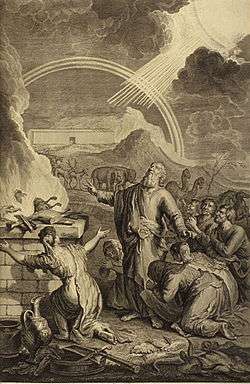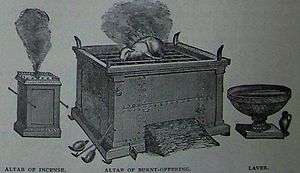Holocaust (sacrifice)
A holocaust is a religious animal sacrifice that is completely consumed by fire. The word derives from the Ancient Greek holokaustos (ὁλόκαυστος from ὅλος "whole" and καυστός "burnt", with rough breathing), which is used solely for one of the major forms of sacrifice. This form of sacrifice is also known as a burnt offering.

Greek sacrifice
Holokautein (ὁλοκαυτεῖν) is one of the two chief verbs of Greek sacrifice, in which the victim is utterly destroyed and burnt up, as opposed to thúesthai (θύεσθαι), to share a meal with the god and one's fellow worshippers, commensal sacrifice. In the latter, the edible parts of the sacrificed animal were roasted and distributed for festive celebration, whereas the inedible parts were burned on the altar, those being the god's share. Although not actually obliged to do so, Greeks would rather sacrifice a domestic animal to a god or hero and then proceed to use its flesh as food, as animals were thought of as sharing in the sanctity of life - in addition to their secular usefulness (milk, eggs, ploughing). This did not apply to game, fish, and other seafood, which formed a far larger proportion of the diet than they do today – fish was the major foodstuff sold in ancient Greek marketplaces. A sacrifice need not be a public function involving priests and altars; they could also be held privately, domestically or individually.
These are the two ideal types of Greek sacrificial ritual; they are appropriate to different divinities, done for different purposes, and conducted by different methods. Holocausts are apotropaic rituals, intended to appease the spirits of the Underworld, including the Greek heroes, who are spirits of the dead; they are also given to dangerous powers, such as the Keres and Hecate. One of the earliest attested holocausts was Xenophon's offering of pigs to Zeus Meilichius.[1]
Holocausts are conducted at night, without wine, and offer black-hided animals at a low altar, with their heads directed downwards; in all these they are opposed to the commensal sacrifice given to the Olympian gods. (This distinction is between extreme types, and was somewhat exaggerated in the early twentieth century, as by Jane Harrison; considerable evidence has also been found of commensal sacrifice offered to heroes.)[2]
Jewish sacrifice

When the Hebrew Bible was translated into Greek, as the Septuagint, the translators used the Greek term to translate the "burnt offering" in Ancient Israel.[3][4] A "burnt offering" (Hebrew: עלה, `olah – from the verb "to cause to ascend," hence "burn") is a type of Biblical sacrifice, specifically an animal sacrifice in which the entire sacrifice is completely burnt, consumed totally by fire. The term "burnt offering" derives from the Septuagint translation, itself deriving from the Biblical phrase "an offering made by fire", which occurs in the description (Leviticus 1) of the offering.[5] This form of sacrifice, in which no meat was left over for anyone, was seen as the greatest form of sacrifice[5] and was the form of sacrifice permitted by Judaism to be given at the Temple by Jews and non-Jews.[5]
The whole offering is believed to have evolved as an extreme form of the slaughter offering, whereby the portion allocated to the deity increased to all of it.[5] In slaughter offerings, the portion allocated to the deity was mainly the fat, the part which can most easily be burnt (fat is quite combustible); scholars believe it was felt that the deity, being aethereal, would appreciate aethereal food more than solid food—the burning of the fatty parts of animals being to produce smoke as a sweet savour for the deity.[5]
Ritual
The animals, having first been checked to ensure they were free from disease and unblemished (a requirement of the sacrifice), were brought to the north side of the altar, and killed by either the offerer, or a priest. The animal's blood was carefully collected by priests and sprinkled around the altar. Unless the animal was a bird, its corpse was flayed, the skin given to the priest (who was permitted to keep it). In later times more powerful priests forcibly took possession of the skins from the lesser priests, and it was decreed that the skins should be sold, with the proceeds being given to the Temple in Jerusalem (Tosefta 19) The flesh of the animal was divided according to detailed instructions given by the Talmud (Tamid 31), and would then be placed on the wood on the altar (which was constantly on fire due the large number of sacrifices carried out daily), and slowly burnt. After the flesh (including any horns and goats' beards) had been reduced to ashes, usually the following morning, the ashes were taken by the priest to a ritually clean location outside the sanctuary, and dumped there.[5]
Most biblical scholars now agree that the intricate details of the whole offering, particularly the types and number of animals on occasion of various feast days, given by the Torah, were of a late origin, as were the intricate directions given in the Talmud.[5] Whole offerings were quite rare in early times, but as the ritual became more fixed and statutory, and the concentration of sacrifice into a single sanctuary (particularly after Josiah's reform) made sacrifices quite distinct from simply killing animals for food, whole offerings gradually rose to great prominence.[5]
See also
- Anthrozoology
- Fire ritual
- Oblation
- Hecatomb
- Tophet
Notes
- Harrison, pp. 16, 161, et passim; LSJ:ὁλόκαυτος; Xenophon, Anabasis, 7.8.
- Harrison p. 161; Brill's New Pauly, "Sacrifice"
- Brown Driver Briggs Hebrew Lexicon entry for olah
- Ancient Israel: its life and institutions Roland De Vaux - 1997 -p415 "The English word 'holocaust' comes, through the Vulgate, from the Septuagint,"
- Jewish Encyclopedia
References
- Jane Harrison, Prolegomena to the study of Greek Religion Princeton University Press, 1991; ISBN 0-691-01514-7
- Brill’s New Pauly : encyclopaedia of the ancient world, 2002- : Vol XII, Prol-Sar, ISBN 978-90-04-14217-6